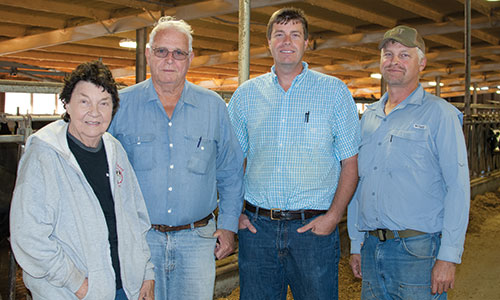
"We have a very detail-oriented nutritionist who monitors processing scores throughout the harvest. This year, the processing scores were in the upper 70s," explained James Coble. "That number is constantly monitored throughout the corn silage harvest and it's a main reason we have a full line of harvesting equipment," said Coble, who heads up cropping at their family farm in Waynesboro, Ga.
"In previous years, we also monitored our scores; they were in the 50s. Even though we had a new processor, it wasn't up to snuff. Then we put in the new rolls and we were in the 70s," said James. "Our dealer thought we didn't need a model 980 Claas, but we wanted to have enough power to run the processor at levels to achieve 70-plus scores."
As for others changes, James noted in the past that inoculant tanks on choppers got too hot. That killed off the inoculant as temperatures approached 100°F. In fact, water has gotten up to 150°F in the inoculant tank. "Now we use a Dohrmann inoculant applicator that is insulated," said the Georgia dairyman.
"When consultants are concerned, we also work some with consultants at our fertilizer company. We started working with a crop consultant and participated in a moisture meter project to measure soil moisture under the center pivots," he went on to explain.
Since relocating their dairy from South Carolina to Georgia in 1998, the Coble family has employed a number of practices to maximize forage yields on their 2,100 acres of irrigated ground. At one time they triple-cropped the land in a ryegrass, corn silage, sorghum-sudangrass rotation. However, issues with sugarcane aphids took the sorghum-sudangrass out of mix.
The Cobles use a variety of methods to store feed, with corn for silage stored on drive-over piles and brown midrib corn silage and ryegrass stored in bags.
By owning harvesting equipment, brothers James and Joel can slow down and achieve processing scores in the upper 70s, which, in turn, helps them with their 80-pound bulk tank average at their 2,400-cow dairy.
Electronic irrigation pumps that are controlled via the internet and a switch to a dormant inoculant applicator have enhanced corn silage production. Shown above (L to R) are: Lana and Ed Coble with their sons Joel and James.
The Harmony Grove Dairy Team also had this to say in response to additional questions focused on "What drives their crops and forages":
When do you harvest forages?
We look at the starch and milk in the ear and evaluate the whole plant dry matter; we target 33 to 34 percent dry matter or 66 to 67 percent moisture. If you come into our office in July, you will find corn ears all over the table as we constantly monitor kernel filling. This year, we harvested in early July because the heat accelerated maturity. Normally we harvest in mid-July.
How are forage and tillage operations handled on your farm?
We have a full line of cropping equipment that includes a self-propelled chopper, straight trucks, packing tractor and bagger. For ryegrass, we have a self-propelled disc windrower, a tedder, and we rake it with a Claas rotary rake. We also own a ripper (strip tiller), harrow, and field cultivators along with a roller for our ryegrass fields. We use a silage rake for feedout and have found it has lower maintenance than a facer.
Have you made changes to tillage operations?
The last two years, strip-till has been a separate operation from planting. We decoupled those operations because we purchased a bigger planter that needed more horsepower on the tractor. We strip-till eight rows and plant with 16-row planters. Our irrigation pumps communicate by radio and we can log in via the internet to control wells and pivots. This is the first year we used this technology and it has worked great.
Do you conduct field trials?
We have been doing corn hybrid trials for five years. We weigh all our feed from hybrid trials and sample those feedstuffs for quality. It does slow up planting and harvesting. GPS has made hybrid trials so much easier.
To learn more about the Harmony Grove Dairy operation, turn to pages 768 to 770 in the December issue to read the Round Table "What drives their crops and forages."
If you are currently not a subscriber, please order a subscription. If you order today, we can be sure you get to read the December issue.
(c) Hoard's Dairyman Intel 2016
January 4, 2016








